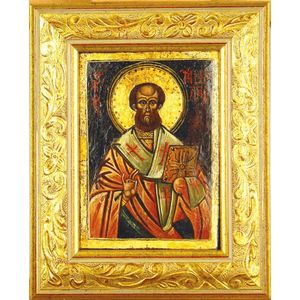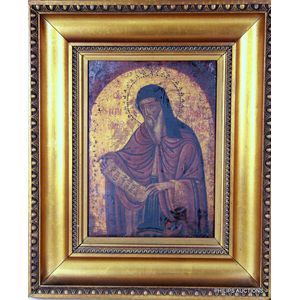Orthodox Prophet or Apostle Icon, 17th Century
You must be a subscriber, and be logged in to view price and dealer details.
Subscribe Now to view actual auction price for this item
When you subscribe, you have the option of setting the currency in which to display prices to $Au, $US, $NZ or Stg.
- Gesso - A mixture of plaster of Paris and gypsum mixed with water and then applied to the carved wooden frames of mirrors and picture frames as a base for applying gold leaf. After numerous coats of gesso have been applied, allowed to dry and then sanded a coat of "bole", a usually red coloured mixture of clay and glue is brushed on and allowed to dry, after which the gold leaf is applied. In painting, gesso is also used to prime a canvas prior to applying paint.
- Gilding - Gilding is a method of ornamentation whereby a thin sheet of gold metal is applied to items made of wood, leather, ceramics, glass and silver for decorative purposes.
For furniture including mirrors, the sheet of gold is usually applied over a coating of gesso. Gesso is a mixture of plaster of Paris and gypsum mixed with water and then applied to the carved wooden frames of mirrors and picture frames as a base for applying the gold leaf. After numerous coats of gesso have been applied, allowed to dry and then sanded a coat of "bole", a usually red coloured mixture of clay and glue is brushed on and allowed to dry, after which the gold leaf is applied. Over time parts of the gilding will rub off so the base colour can be seen. In water gilding, this was generally a blue colour, while in oil gilding, the under layer was often yellow. In Victorian times, gilders frequently used red as a pigment beneath the gold leaf.
Metal was often gilded by a process known as fire gilding. Gold mixed with mercury was applied and heated, causing the mercury to evaporate, the long-term effect of which was to kill or disable the craftsman or woman from mercury poisoning. The pursuit of beauty has claimed many victims, not the least of which were the artists who made those pieces so highly sought after today.
This item has been included into following indexes:
Visually similar items

E. Lembeye, French Woman, oil on board, signed and dated lower right 1885, 45 c 28 cm

Three framed hand coloured engravings, prints of originals dated circa 1765, by John Hill. Certificates of Authenticity from Discovery, Noosa, Queensland, available. 38 cm X 23 cm (average)

Gustav Pillig (1877-1956), Elegance, oil on cardboard, signed lower left, 30 x 24 cm

A Greek orthodox Russian icon, painted with Christ (Pantokrator), 'The Almighty' with halo to his head, his right hand raised with finger and thumb touching, gilt enrichments. 19.5 x 14.5 cm, later gilt frame
